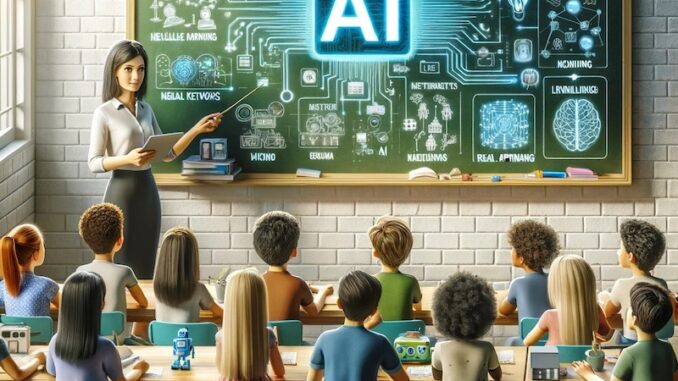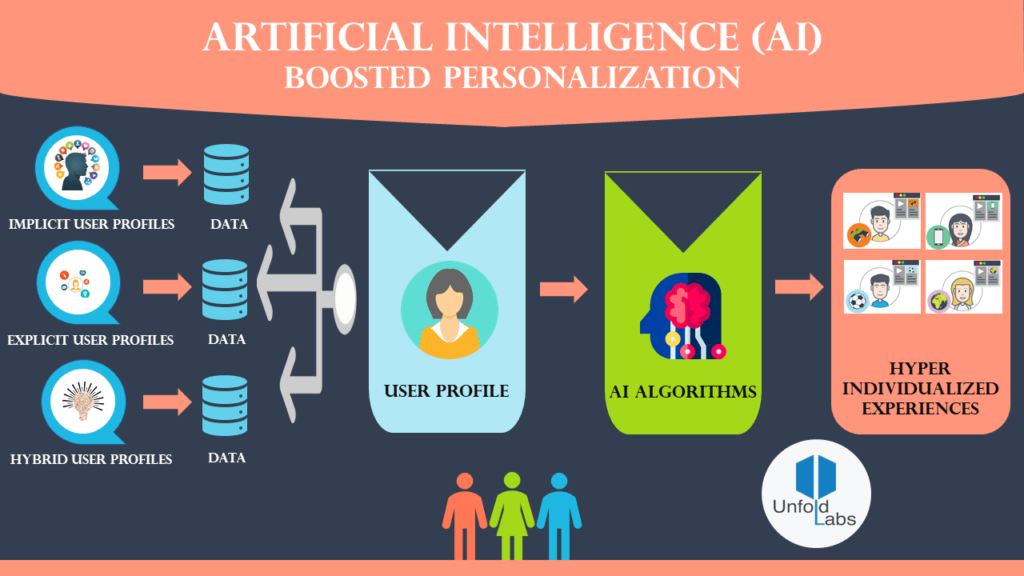
Artificial Intelligence (AI) has been a great tool that has only grown over the last handful of years. In some ways, AI has worked its way into everyday life. From social media platforms to hospitals and more, AI has increasingly become more useful and used. As more people young and old use this tool, there are some key details to watch out for. Join us as we look over the uses and pitfalls of AI in the classroom!

Logging On
While AI is just a tool, this can lead to some problems if not handled correctly. One of these problems is the misrepresentation and/or underrepresentation of minority groups. Simply put, if the data you are reviewing skews towards a majority, the output produced may skew this way as well. In a similar sense, AI can end up aligning too closely with specific user perspectives if it’s frequently used by groups with similar opinions, which might reinforce existing biases. While this confirmation bias is not always present, users should be aware that this may happen for students and teachers alike.
In order to address these biases, there are a few simple things each person can do in order to get the best results. It is good to remember that AI is a tool, and just like a hammer or a drill, issues are typically due to the user of the tool. When using AI, how you state the prompt or input data could determine the output you get. Specific questions are necessary for the results you are looking for. For example, if you ask how the Declaration of Independence affected America, you would probably get a blanket statement of the colonists being happy with it. While many people were happy about it, there are groups who weren’t. The perspective of the loyalist who still supported British rule is not shown. The perspective of women and African Americans who could not share that independence is surely missing as well. By asking how the Declaration of Independence affected all of these groups, the issue of underrepresentation can be rectified.
The adage for teachers when using AI is to always double check the information to make sure it is correct. Similarly, we must double check for underrepresentation and confirmation biases. I encourage everybody to read over this article from Edutopia that goes into more depth of the biases in AI listed below. If you don’t think these biases exist, try the “hairstyle” experiment early on in this article.
https://www.edutopia.org/article/equity-bias-ai-what-educators-should-know/
TCE Thresholds and AI:

- Teaching is/as intellectual engagement: When looking at AI in the classroom as a teacher, you are effectively using it as a tool. This tool can be used to facilitate critical thinking based on tailored questions, discussion prompts, or problem solving scenarios that students on all levels can engage with. The use of AI can be great for brainstorming ideas and introducing new sources, viewpoints, and materials. As a teacher, data driven AI can produce individualized questions or prompts in order to fill gaps that the student may have. By personalizing education towards the student, AI can produce unique reflection questions for students to assess themselves in a way that is meaningful to them.
- Education is not neutral/Teaching is political: AI helps reinforce that education is inherently impactful on society and politics by enabling educators to approach teaching with an awareness of power dynamics, bias, and equity, offering tools to navigate this responsibly and inclusively.
AI tools often include features that make learning more accessible, like language translation, speech-to-text, or reading support for students with learning disabilities. This contributes to educational equity, ensuring that students from diverse backgrounds and abilities can access learning equally and fully participate.
AI in Social Studies

I have used AI in the classroom in a variety of ways from helping brainstorm the pacing of my curriculum, to generating short homework assignments. This specific week however, I used AI to create a discussion on misinformation. For context, we are looking at the Boston Massacre and Paul Revere’s inaccurate depiction of the events that night, and how the picture spread throughout the colonies. As the lesson opened, students were asked if they trust the news, and if not, where they got their news from. This started a discussion on some not trusting large news sources, some just getting news from their parents, and others admitting that they do not keep up on the news. As the discussion went on, students came to the idea that if multiple sources say the same thing, then it is probably right.
I asked students to pretend they were journalists on the night of the massacre, and had to ask questions in order to get the full story. Students were to write 5 questions down and ask them to ChatGPT in order to see how different questions can result in different answers. Ultimately, students were to write a rebuttal to Paul Revere based on the collection of answers they received. Later there was the talk about perception being greater than reality, and that if so many people believe a lie (or an inaccuracy with the Paul Revere picture), then in the grand scheme, is it a lie?
What went well with this is the student engagement that came with it. Students were excited to try out different questions and see the different results. This activity provided a chance for each student to reflect on each question and ultimately create new and better questions. It was also nice that if a student did not understand the output, they could just ask for a simpler text and receive it immediately.
If I were to do this again, I would have students limit each response. This can be done by just saying “In one to two paragraphs, can you tell me…” as ChatGPT can go into longer texts that can be daunting for students before they even read it. I gave students 15 minutes to complete this, since it is the first time we have explicitly used AI in class. Next time I would probably shorten this to 7-10 minutes, and also be more vigilant of students going down the rabbit hole of questions not pertaining to the assignment. While I understand that not everybody is a middle school social studies teachers, I encourage teachers to watch this video below for some extra tips on how AI can benefit your classroom.
Pros and Cons of AI:
Pros:
- Individualized Instruction: AI enables personalized education by tailoring lessons, quizzes, and assignments to meet each student’s learning pace and style. Adaptive learning platforms, like Successmaker or Knewton (not free unfortunately), adjust content based on student progress, helping students who need extra practice and challenging those who excel.
- Efficiency: AI can streamline administrative tasks such as grading, attendance tracking, and progress reporting, freeing up time for teachers to focus more on instruction, engagement, and building relationships. With easy to use AI resources, teachers of all tech levels can incorporate AI into their curriculum.
- Ease of Resources: For teachers, creating resources can be the hardest part of your day. Through AI, resources can be found and even created in no time at all. AI tools can even differentiate your lesson to meet most accommodations. For students, AI can be a 24/7 tool for new resources to help them learn at their own pace and educational level.
Cons:
- Overreliance: Just like with any new tool or invention, some may think that AI can now replace the planning and work that goes into teaching. Unfortunately, this is not the case. While AI is a good tool, it does not replace the one on one interactions with students and the understanding that AI simply cannot pick up on. You wouldn’t want students to use AI to write a paper, so why would it be write for AI to create entire lessons? Moderation is the key to use AI as a tool, and not a crutch.
- Biases: As discussed earlier, there is the potential for biases that may result in misinformation and underrepresentation of minority groups. By being specific with our questions and allowing for diversity in our data inputs, we can help reduce these biases.
- Going unchecked: Improper monitoring of AI can lead to teachers being taken advantage of when it comes to the use of AI. With more AI sites popping up, including those that make AI less detectable, the possibility to cheat opens up. It is up to the teachers to monitor students closely when using AI. This is not only getting up and walking around, but learning how your students write, or even talk. The more you know about your student, the easier you can tell if they are cheating or not.
If you are curious if AI is right for you in the classroom and would like more information on the pros and cons, please check this article to decide for yourself: https://www.classpoint.io/blog/the-pros-and-cons-of-ai-in-education

I think the engagement you saw from your students is great! Getting students engaged in learning can often be a struggle, how do you think you can build off of that momentum?
I think something we can do is to learn how to fact check claims that they choose. Especially with it being election season, there are many claims on all levels that can be put under a microscope. At this point, it may lead to a discussion on ethics in politics, and whether you can trust somebody that you just found out is not telling the truth. It may lead to some awkward family dinners around Thanksgiving, but it would be for the best.
Hi Andrew, I think you make a great point with the personalization we can gain from AI that would take us days, even weeks to achieve before! I didn’t know about successmaker that adjusts as students go either, that is incredible! Have you tried it out yet? I wonder how effective it is? I also wonder what work you’ve done to ensure you know your students well enough to go deep into this individualization of work. How are you collecting and using data to help you impliment this?
Hi Annie, thank you for the kind words! Admittedly, I do not use Successmaker for social studies, but I do have a “flex class” where I do progress monitoring for 7th grade math. Essentially, the math teacher sets levels for different skills (fractions, long division, etc.) that builds upon itself and gets harder. Students take a pre-test to determine where they are (I think MAP scores also go into it) and the site places them at their own individual start. Over time, and depending on the students…success, the site will incrementally increase the difficultly. Repeated missed questions will result in a lower question that is more broken down. It’s all really cool actually. I think it has expanded to language arts too, so hopefully it will make it to us soon!